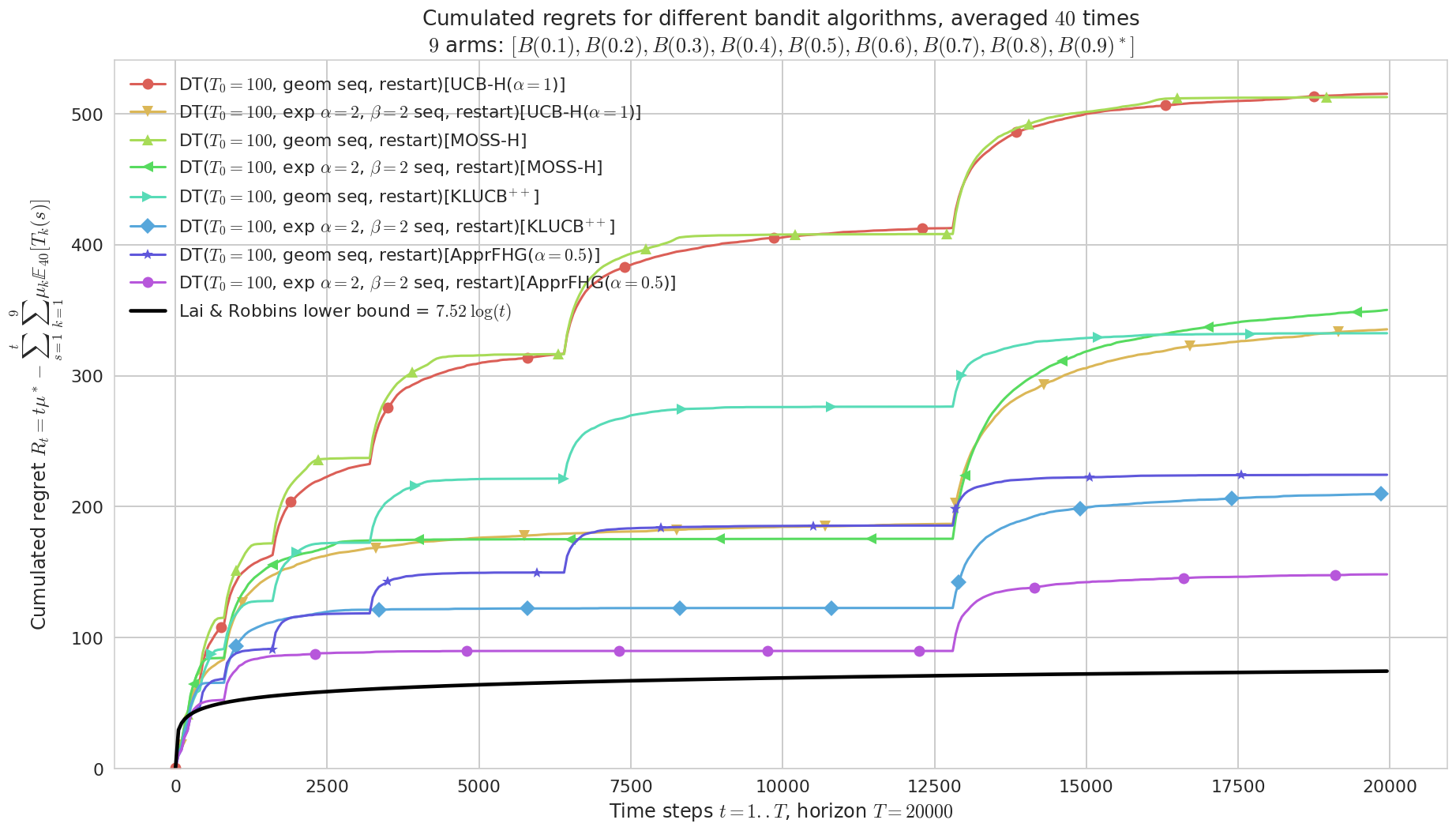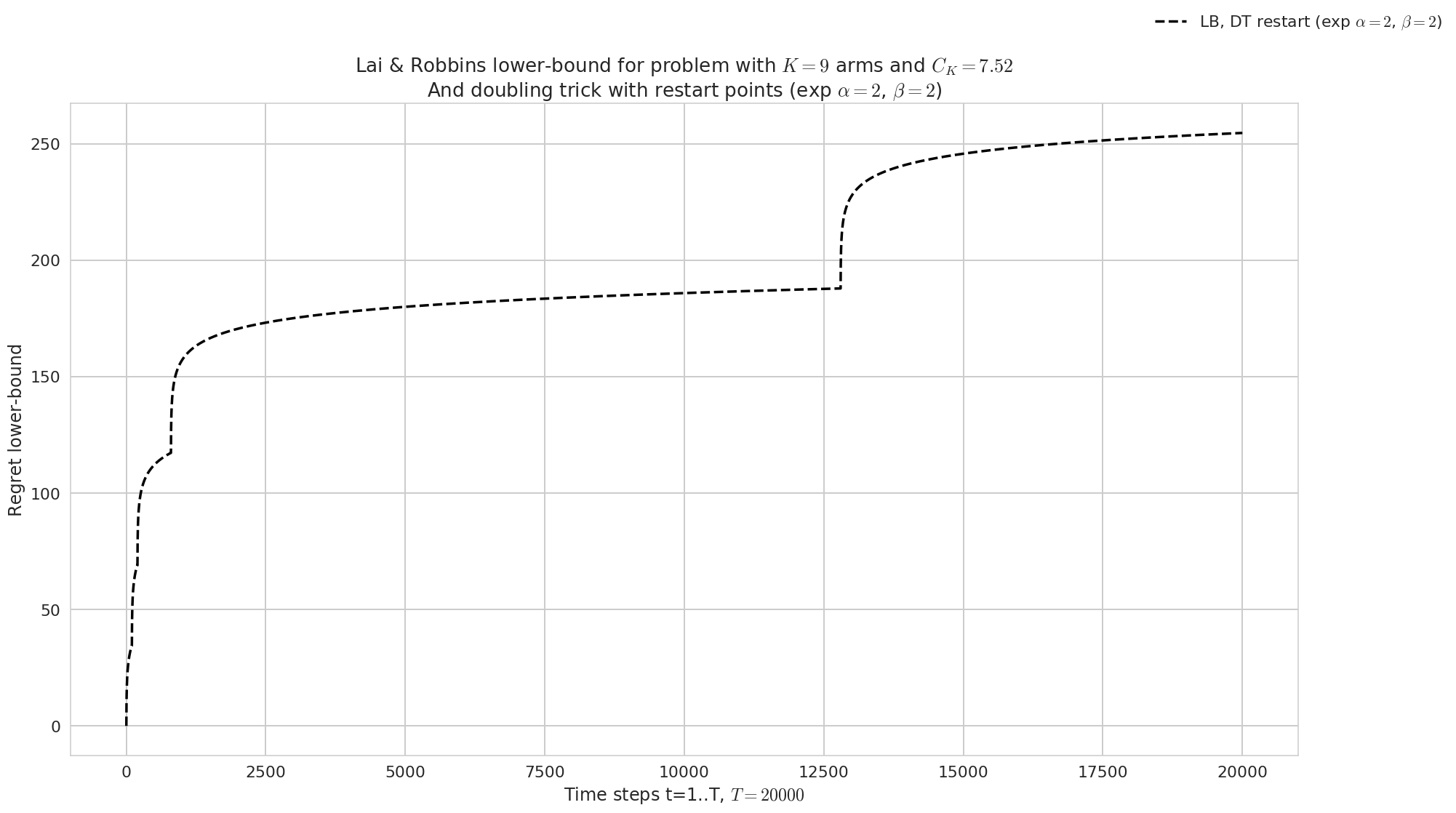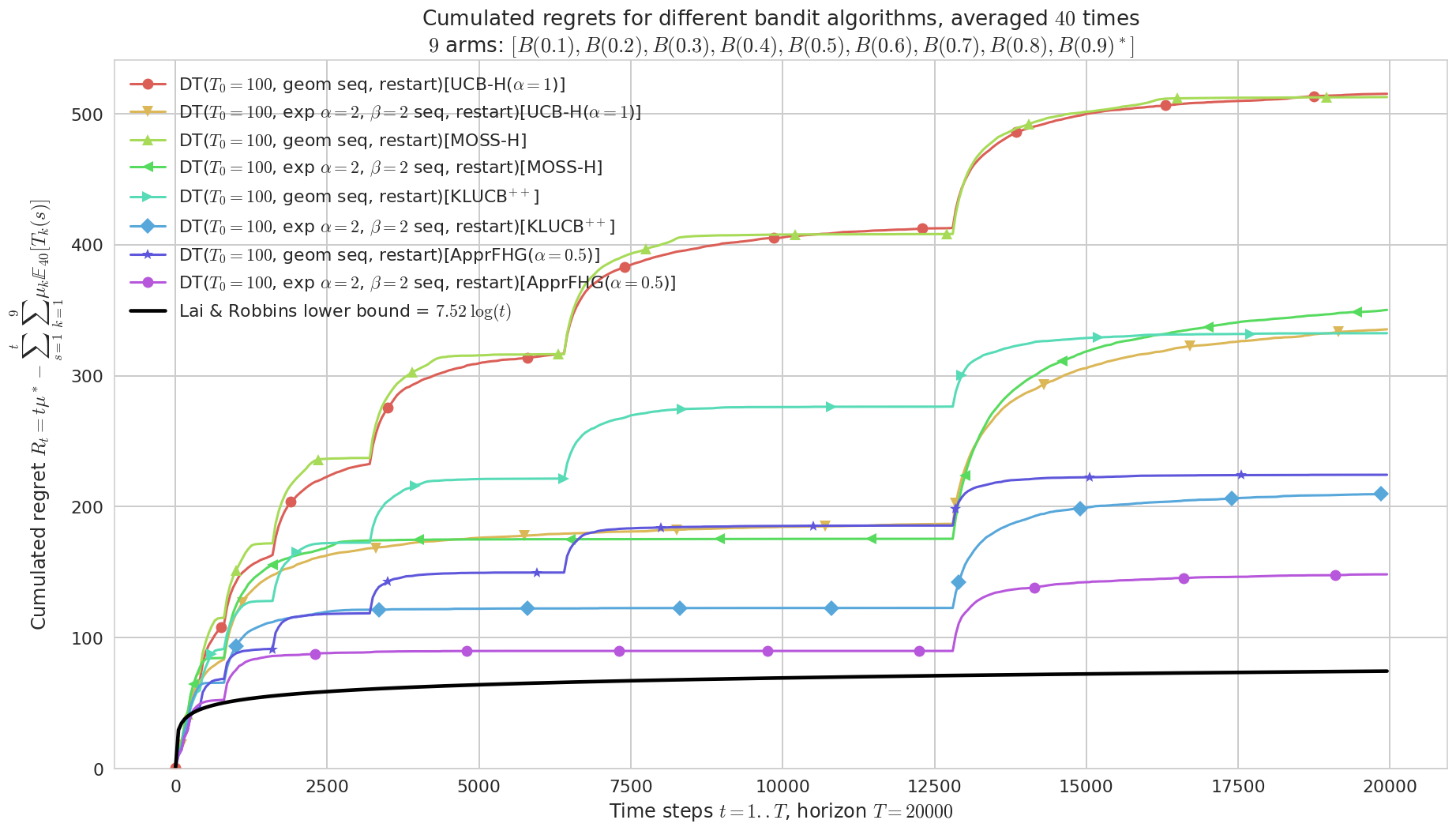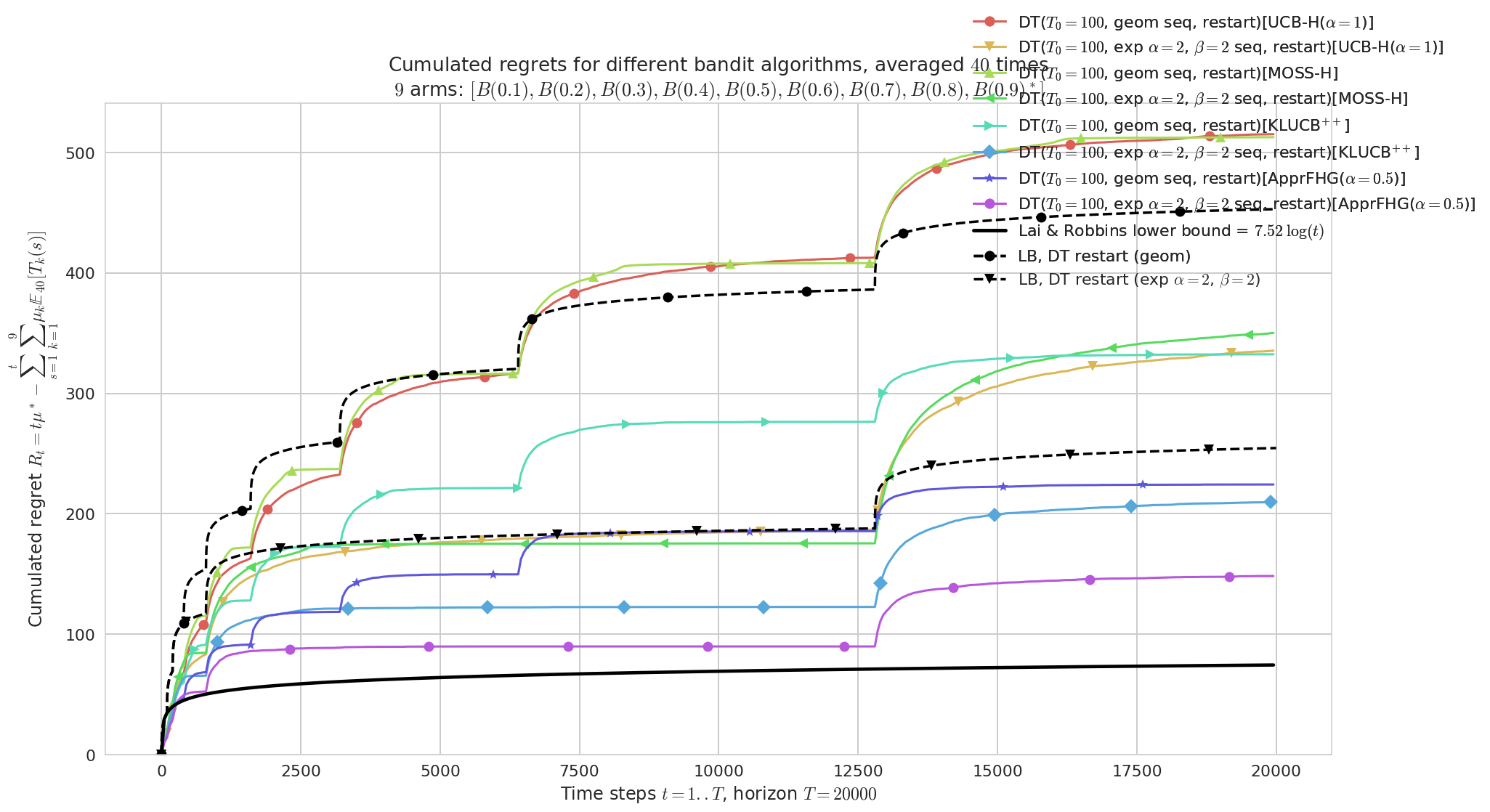Table of Contents¶
1 Lai & Robbins lower-bound for stochastic bandit with full restart points
1.1 Creating the problem
1.1.1 Parameters for the simulation
1.1.2 Some MAB problem with Bernoulli arms
1.1.3 Some RL algorithms
1.2 Creating the Evaluator object
1.3 Solving the problem
1.4 Plotting the results
1.5 Visualisation the lower-bound for algorithms that restart at breaking points
1.6 Seeing the lower-bound on the regret plot
1.7 Conclusion
Lai & Robbins lower-bound for stochastic bandit with full restart points¶
First, be sure to be in the main folder, and import Evaluator from
Environment package:
In [1]:
import matplotlib as mpl
mpl.rcParams['figure.figsize'] = (16, 9)
import numpy as np
import matplotlib.pyplot as plt
In [2]:
from sys import path
path.insert(0, '..')
In [3]:
# Local imports
from Environment import Evaluator, tqdm
from Environment.plotsettings import legend, makemarkers
- Setting dpi of all figures to 110 ...
- Setting 'figsize' of all figures to (19.8, 10.8) ...
Info: Using the Jupyter notebook version of the tqdm() decorator, tqdm_notebook() ...
We also need arms, for instance Bernoulli-distributed arm:
In [4]:
# Import arms
from Arms import Bernoulli
Info: numba.jit seems to be available.
And finally we need some single-player Reinforcement Learning algorithms:
In [5]:
# Import algorithms
from Policies import *
Info: numba.jit seems to be available.
Creating the problem¶
Parameters for the simulation¶
- \(T = 20000\) is the time horizon,
- \(N = 40\) is the number of repetitions,
N_JOBS = 4is the number of cores used to parallelize the code.
In [6]:
HORIZON = 20000
REPETITIONS = 40
N_JOBS = 4
Some MAB problem with Bernoulli arms¶
We consider in this example \(3\) problems, with Bernoulli arms,
of different means.
In [7]:
ENVIRONMENTS = [ # 1) Bernoulli arms
{ # A very easy problem, but it is used in a lot of articles
"arm_type": Bernoulli,
"params": [0.1, 0.2, 0.3, 0.4, 0.5, 0.6, 0.7, 0.8, 0.9]
}
]
Some RL algorithms¶
We compare some policies that use the
`DoublingTrickWrapper <https://smpybandits.github.io/docs/Policies.DoublingTrickWrapper.html#module-Policies.DoublingTrickWrapper>`__
policy, with a common growing scheme.
In [8]:
NEXT_HORIZONS = [
# next_horizon__arithmetic,
next_horizon__geometric,
# next_horizon__exponential,
# next_horizon__exponential_slow,
next_horizon__exponential_generic
]
In [9]:
POLICIES = [
# --- Doubling trick algorithm
{
"archtype": DoublingTrickWrapper,
"params": {
"next_horizon": next_horizon,
"full_restart": full_restart,
"policy": policy,
}
}
for policy in [
UCBH,
MOSSH,
klUCBPlusPlus,
ApproximatedFHGittins,
]
for full_restart in [
True,
# False,
]
for next_horizon in NEXT_HORIZONS
]
Complete configuration for the problem:
In [10]:
configuration = {
# --- Duration of the experiment
"horizon": HORIZON,
# --- Number of repetition of the experiment (to have an average)
"repetitions": REPETITIONS,
# --- Parameters for the use of joblib.Parallel
"n_jobs": N_JOBS, # = nb of CPU cores
"verbosity": 6, # Max joblib verbosity
# --- Arms
"environment": ENVIRONMENTS,
# --- Algorithms
"policies": POLICIES,
}
configuration
Out[10]:
{'environment': [{'arm_type': Arms.Bernoulli.Bernoulli,
'params': [0.1, 0.2, 0.3, 0.4, 0.5, 0.6, 0.7, 0.8, 0.9]}],
'horizon': 20000,
'n_jobs': 4,
'policies': [{'archtype': Policies.DoublingTrickWrapper.DoublingTrickWrapper,
'params': {'full_restart': True,
'next_horizon': <function Policies.DoublingTrickWrapper.next_horizon__geometric>,
'policy': Policies.UCBH.UCBH}},
{'archtype': Policies.DoublingTrickWrapper.DoublingTrickWrapper,
'params': {'full_restart': True,
'next_horizon': <function Policies.DoublingTrickWrapper.next_horizon__exponential_generic>,
'policy': Policies.UCBH.UCBH}},
{'archtype': Policies.DoublingTrickWrapper.DoublingTrickWrapper,
'params': {'full_restart': True,
'next_horizon': <function Policies.DoublingTrickWrapper.next_horizon__geometric>,
'policy': Policies.MOSSH.MOSSH}},
{'archtype': Policies.DoublingTrickWrapper.DoublingTrickWrapper,
'params': {'full_restart': True,
'next_horizon': <function Policies.DoublingTrickWrapper.next_horizon__exponential_generic>,
'policy': Policies.MOSSH.MOSSH}},
{'archtype': Policies.DoublingTrickWrapper.DoublingTrickWrapper,
'params': {'full_restart': True,
'next_horizon': <function Policies.DoublingTrickWrapper.next_horizon__geometric>,
'policy': Policies.klUCBPlusPlus.klUCBPlusPlus}},
{'archtype': Policies.DoublingTrickWrapper.DoublingTrickWrapper,
'params': {'full_restart': True,
'next_horizon': <function Policies.DoublingTrickWrapper.next_horizon__exponential_generic>,
'policy': Policies.klUCBPlusPlus.klUCBPlusPlus}},
{'archtype': Policies.DoublingTrickWrapper.DoublingTrickWrapper,
'params': {'full_restart': True,
'next_horizon': <function Policies.DoublingTrickWrapper.next_horizon__geometric>,
'policy': Policies.ApproximatedFHGittins.ApproximatedFHGittins}},
{'archtype': Policies.DoublingTrickWrapper.DoublingTrickWrapper,
'params': {'full_restart': True,
'next_horizon': <function Policies.DoublingTrickWrapper.next_horizon__exponential_generic>,
'policy': Policies.ApproximatedFHGittins.ApproximatedFHGittins}}],
'repetitions': 40,
'verbosity': 6}
Creating the Evaluator object¶
In [11]:
evaluation = Evaluator(configuration)
Number of policies in this comparison: 8
Time horizon: 20000
Number of repetitions: 40
Sampling rate for plotting, delta_t_plot: 50
Number of jobs for parallelization: 4
Creating a new MAB problem ...
Reading arms of this MAB problem from a dictionnary 'configuration' = {'arm_type': <class 'Arms.Bernoulli.Bernoulli'>, 'params': [0.1, 0.2, 0.3, 0.4, 0.5, 0.6, 0.7, 0.8, 0.9]} ...
- with 'arm_type' = <class 'Arms.Bernoulli.Bernoulli'>
- with 'params' = [0.1, 0.2, 0.3, 0.4, 0.5, 0.6, 0.7, 0.8, 0.9]
- with 'arms' = [B(0.1), B(0.2), B(0.3), B(0.4), B(0.5), B(0.6), B(0.7), B(0.8), B(0.9)]
- with 'means' = [0.1 0.2 0.3 0.4 0.5 0.6 0.7 0.8 0.9]
- with 'nbArms' = 9
- with 'maxArm' = 0.9
- with 'minArm' = 0.1
This MAB problem has:
- a [Lai & Robbins] complexity constant C(mu) = 7.52 ...
- a Optimal Arm Identification factor H_OI(mu) = 48.89% ...
- with 'arms' represented as: $[B(0.1), B(0.2), B(0.3), B(0.4), B(0.5), B(0.6), B(0.7), B(0.8), B(0.9)^*]$
Number of environments to try: 1
Solving the problem¶
Now we can simulate all the \(3\) environments. That part can take some time.
In [12]:
for envId, env in tqdm(enumerate(evaluation.envs), desc="Problems"):
# Evaluate just that env
evaluation.startOneEnv(envId, env)
Evaluating environment: MAB(nbArms: 9, arms: [B(0.1), B(0.2), B(0.3), B(0.4), B(0.5), B(0.6), B(0.7), B(0.8), B(0.9)], minArm: 0.1, maxArm: 0.9)
- Adding policy #1 = {'archtype': <class 'Policies.DoublingTrickWrapper.DoublingTrickWrapper'>, 'params': {'next_horizon': <function next_horizon__geometric at 0x7f8c7ea81d90>, 'full_restart': True, 'policy': <class 'Policies.UCBH.UCBH'>}} ...
Creating this policy from a dictionnary 'self.cfg['policies'][0]' = {'archtype': <class 'Policies.DoublingTrickWrapper.DoublingTrickWrapper'>, 'params': {'next_horizon': <function next_horizon__geometric at 0x7f8c7ea81d90>, 'full_restart': True, 'policy': <class 'Policies.UCBH.UCBH'>}} ...
- Adding policy #2 = {'archtype': <class 'Policies.DoublingTrickWrapper.DoublingTrickWrapper'>, 'params': {'next_horizon': <function next_horizon__exponential_generic at 0x7f8c7ea8f048>, 'full_restart': True, 'policy': <class 'Policies.UCBH.UCBH'>}} ...
Creating this policy from a dictionnary 'self.cfg['policies'][1]' = {'archtype': <class 'Policies.DoublingTrickWrapper.DoublingTrickWrapper'>, 'params': {'next_horizon': <function next_horizon__exponential_generic at 0x7f8c7ea8f048>, 'full_restart': True, 'policy': <class 'Policies.UCBH.UCBH'>}} ...
- Adding policy #3 = {'archtype': <class 'Policies.DoublingTrickWrapper.DoublingTrickWrapper'>, 'params': {'next_horizon': <function next_horizon__geometric at 0x7f8c7ea81d90>, 'full_restart': True, 'policy': <class 'Policies.MOSSH.MOSSH'>}} ...
Creating this policy from a dictionnary 'self.cfg['policies'][2]' = {'archtype': <class 'Policies.DoublingTrickWrapper.DoublingTrickWrapper'>, 'params': {'next_horizon': <function next_horizon__geometric at 0x7f8c7ea81d90>, 'full_restart': True, 'policy': <class 'Policies.MOSSH.MOSSH'>}} ...
- Adding policy #4 = {'archtype': <class 'Policies.DoublingTrickWrapper.DoublingTrickWrapper'>, 'params': {'next_horizon': <function next_horizon__exponential_generic at 0x7f8c7ea8f048>, 'full_restart': True, 'policy': <class 'Policies.MOSSH.MOSSH'>}} ...
Creating this policy from a dictionnary 'self.cfg['policies'][3]' = {'archtype': <class 'Policies.DoublingTrickWrapper.DoublingTrickWrapper'>, 'params': {'next_horizon': <function next_horizon__exponential_generic at 0x7f8c7ea8f048>, 'full_restart': True, 'policy': <class 'Policies.MOSSH.MOSSH'>}} ...
- Adding policy #5 = {'archtype': <class 'Policies.DoublingTrickWrapper.DoublingTrickWrapper'>, 'params': {'next_horizon': <function next_horizon__geometric at 0x7f8c7ea81d90>, 'full_restart': True, 'policy': <class 'Policies.klUCBPlusPlus.klUCBPlusPlus'>}} ...
Creating this policy from a dictionnary 'self.cfg['policies'][4]' = {'archtype': <class 'Policies.DoublingTrickWrapper.DoublingTrickWrapper'>, 'params': {'next_horizon': <function next_horizon__geometric at 0x7f8c7ea81d90>, 'full_restart': True, 'policy': <class 'Policies.klUCBPlusPlus.klUCBPlusPlus'>}} ...
- Adding policy #6 = {'archtype': <class 'Policies.DoublingTrickWrapper.DoublingTrickWrapper'>, 'params': {'next_horizon': <function next_horizon__exponential_generic at 0x7f8c7ea8f048>, 'full_restart': True, 'policy': <class 'Policies.klUCBPlusPlus.klUCBPlusPlus'>}} ...
Creating this policy from a dictionnary 'self.cfg['policies'][5]' = {'archtype': <class 'Policies.DoublingTrickWrapper.DoublingTrickWrapper'>, 'params': {'next_horizon': <function next_horizon__exponential_generic at 0x7f8c7ea8f048>, 'full_restart': True, 'policy': <class 'Policies.klUCBPlusPlus.klUCBPlusPlus'>}} ...
- Adding policy #7 = {'archtype': <class 'Policies.DoublingTrickWrapper.DoublingTrickWrapper'>, 'params': {'next_horizon': <function next_horizon__geometric at 0x7f8c7ea81d90>, 'full_restart': True, 'policy': <class 'Policies.ApproximatedFHGittins.ApproximatedFHGittins'>}} ...
Creating this policy from a dictionnary 'self.cfg['policies'][6]' = {'archtype': <class 'Policies.DoublingTrickWrapper.DoublingTrickWrapper'>, 'params': {'next_horizon': <function next_horizon__geometric at 0x7f8c7ea81d90>, 'full_restart': True, 'policy': <class 'Policies.ApproximatedFHGittins.ApproximatedFHGittins'>}} ...
- Adding policy #8 = {'archtype': <class 'Policies.DoublingTrickWrapper.DoublingTrickWrapper'>, 'params': {'next_horizon': <function next_horizon__exponential_generic at 0x7f8c7ea8f048>, 'full_restart': True, 'policy': <class 'Policies.ApproximatedFHGittins.ApproximatedFHGittins'>}} ...
Creating this policy from a dictionnary 'self.cfg['policies'][7]' = {'archtype': <class 'Policies.DoublingTrickWrapper.DoublingTrickWrapper'>, 'params': {'next_horizon': <function next_horizon__exponential_generic at 0x7f8c7ea8f048>, 'full_restart': True, 'policy': <class 'Policies.ApproximatedFHGittins.ApproximatedFHGittins'>}} ...
- Evaluating policy #1/8: DT($T_0=100$, geom seq, restart)[UCB-H($\alpha=1$)] ...
Estimated order by the policy DT($T_0=100$, geom seq, restart)[UCB-H($T=25600$, $\alpha=1$)] after 20000 steps: [3 5 1 2 4 0 6 7 8] ...
==> Optimal arm identification: 100.00% (relative success)...
==> Manhattan distance from optimal ordering: 65.43% (relative success)...
==> Gestalt distance from optimal ordering: 66.67% (relative success)...
==> Mean distance from optimal ordering: 66.05% (relative success)...
[Parallel(n_jobs=4)]: Done 5 tasks | elapsed: 3.1s
[Parallel(n_jobs=4)]: Done 40 out of 40 | elapsed: 14.4s remaining: 0.0s
[Parallel(n_jobs=4)]: Done 40 out of 40 | elapsed: 14.4s finished
- Evaluating policy #2/8: DT($T_0=100$, exp $\alpha=2$, $\beta=2$ seq, restart)[UCB-H($\alpha=1$)] ...
Estimated order by the policy DT($T_0=100$, exp $\alpha=2$, $\beta=2$ seq, restart)[UCB-H($T=3276800$, $\alpha=1$)] after 20000 steps: [1 4 0 2 5 3 7 6 8] ...
==> Optimal arm identification: 100.00% (relative success)...
==> Manhattan distance from optimal ordering: 70.37% (relative success)...
==> Gestalt distance from optimal ordering: 55.56% (relative success)...
==> Mean distance from optimal ordering: 62.96% (relative success)...
[Parallel(n_jobs=4)]: Done 5 tasks | elapsed: 2.8s
[Parallel(n_jobs=4)]: Done 40 out of 40 | elapsed: 14.5s remaining: 0.0s
[Parallel(n_jobs=4)]: Done 40 out of 40 | elapsed: 14.5s finished
- Evaluating policy #3/8: DT($T_0=100$, geom seq, restart)[MOSS-H] ...
Estimated order by the policy DT($T_0=100$, geom seq, restart)[MOSS-H($T=25600$)] after 20000 steps: [0 1 4 3 6 5 2 7 8] ...
==> Optimal arm identification: 100.00% (relative success)...
==> Manhattan distance from optimal ordering: 80.25% (relative success)...
==> Gestalt distance from optimal ordering: 66.67% (relative success)...
==> Mean distance from optimal ordering: 73.46% (relative success)...
[Parallel(n_jobs=4)]: Done 5 tasks | elapsed: 2.8s
[Parallel(n_jobs=4)]: Done 40 out of 40 | elapsed: 14.6s remaining: 0.0s
[Parallel(n_jobs=4)]: Done 40 out of 40 | elapsed: 14.6s finished
- Evaluating policy #4/8: DT($T_0=100$, exp $\alpha=2$, $\beta=2$ seq, restart)[MOSS-H] ...
Estimated order by the policy DT($T_0=100$, exp $\alpha=2$, $\beta=2$ seq, restart)[MOSS-H($T=3276800$)] after 20000 steps: [2 3 0 1 6 4 7 5 8] ...
==> Optimal arm identification: 100.00% (relative success)...
==> Manhattan distance from optimal ordering: 65.43% (relative success)...
==> Gestalt distance from optimal ordering: 55.56% (relative success)...
==> Mean distance from optimal ordering: 60.49% (relative success)...
[Parallel(n_jobs=4)]: Done 5 tasks | elapsed: 3.4s
[Parallel(n_jobs=4)]: Done 40 out of 40 | elapsed: 15.2s remaining: 0.0s
[Parallel(n_jobs=4)]: Done 40 out of 40 | elapsed: 15.2s finished
- Evaluating policy #5/8: DT($T_0=100$, geom seq, restart)[KLUCB$^{++}$] ...
Estimated order by the policy DT($T_0=100$, geom seq, restart)[KLUCB$^{++}$($T=25600$)] after 20000 steps: [0 4 1 2 5 7 3 6 8] ...
==> Optimal arm identification: 100.00% (relative success)...
==> Manhattan distance from optimal ordering: 70.37% (relative success)...
==> Gestalt distance from optimal ordering: 66.67% (relative success)...
==> Mean distance from optimal ordering: 68.52% (relative success)...
[Parallel(n_jobs=4)]: Done 5 tasks | elapsed: 6.4s
[Parallel(n_jobs=4)]: Done 40 out of 40 | elapsed: 33.1s remaining: 0.0s
[Parallel(n_jobs=4)]: Done 40 out of 40 | elapsed: 33.1s finished
- Evaluating policy #6/8: DT($T_0=100$, exp $\alpha=2$, $\beta=2$ seq, restart)[KLUCB$^{++}$] ...
Estimated order by the policy DT($T_0=100$, exp $\alpha=2$, $\beta=2$ seq, restart)[KLUCB$^{++}$($T=3276800$)] after 20000 steps: [0 1 6 5 2 3 4 7 8] ...
==> Optimal arm identification: 100.00% (relative success)...
==> Manhattan distance from optimal ordering: 70.37% (relative success)...
==> Gestalt distance from optimal ordering: 77.78% (relative success)...
==> Mean distance from optimal ordering: 74.07% (relative success)...
[Parallel(n_jobs=4)]: Done 5 tasks | elapsed: 6.9s
[Parallel(n_jobs=4)]: Done 40 out of 40 | elapsed: 37.4s remaining: 0.0s
[Parallel(n_jobs=4)]: Done 40 out of 40 | elapsed: 37.4s finished
- Evaluating policy #7/8: DT($T_0=100$, geom seq, restart)[ApprFHG($\alpha=0.5$)] ...
Estimated order by the policy DT($T_0=100$, geom seq, restart)[ApprFHG($T=25600$, $\alpha=0.5$)] after 20000 steps: [0 1 5 2 3 4 7 6 8] ...
==> Optimal arm identification: 100.00% (relative success)...
==> Manhattan distance from optimal ordering: 80.25% (relative success)...
==> Gestalt distance from optimal ordering: 77.78% (relative success)...
==> Mean distance from optimal ordering: 79.01% (relative success)...
[Parallel(n_jobs=4)]: Done 5 tasks | elapsed: 3.0s
[Parallel(n_jobs=4)]: Done 40 out of 40 | elapsed: 16.2s remaining: 0.0s
[Parallel(n_jobs=4)]: Done 40 out of 40 | elapsed: 16.2s finished
- Evaluating policy #8/8: DT($T_0=100$, exp $\alpha=2$, $\beta=2$ seq, restart)[ApprFHG($\alpha=0.5$)] ...
Estimated order by the policy DT($T_0=100$, exp $\alpha=2$, $\beta=2$ seq, restart)[ApprFHG($T=3276800$, $\alpha=0.5$)] after 20000 steps: [1 3 0 6 5 4 2 7 8] ...
==> Optimal arm identification: 100.00% (relative success)...
==> Manhattan distance from optimal ordering: 65.43% (relative success)...
==> Gestalt distance from optimal ordering: 55.56% (relative success)...
==> Mean distance from optimal ordering: 60.49% (relative success)...
[Parallel(n_jobs=4)]: Done 5 tasks | elapsed: 3.1s
[Parallel(n_jobs=4)]: Done 40 out of 40 | elapsed: 16.5s remaining: 0.0s
[Parallel(n_jobs=4)]: Done 40 out of 40 | elapsed: 16.5s finished
Plotting the results¶
And finally, visualize them, with the plotting method of a Evaluator
object:
In [13]:
def plotAll(evaluation, envId):
evaluation.printFinalRanking(envId)
fig = evaluation.plotRegrets(envId)
# evaluation.plotRegrets(envId, semilogx=True)
# evaluation.plotRegrets(envId, meanRegret=True)
# evaluation.plotBestArmPulls(envId)
return fig
In [14]:
fig = plotAll(evaluation, 0)
Final ranking for this environment #0 :
- Policy 'DT($T_0=100$, exp $\alpha=2$, $\beta=2$ seq, restart)[ApprFHG($\alpha=0.5$)]' was ranked 1 / 8 for this simulation (last regret = 148.29).
- Policy 'DT($T_0=100$, exp $\alpha=2$, $\beta=2$ seq, restart)[KLUCB$^{++}$]' was ranked 2 / 8 for this simulation (last regret = 209.7).
- Policy 'DT($T_0=100$, geom seq, restart)[ApprFHG($\alpha=0.5$)]' was ranked 3 / 8 for this simulation (last regret = 224.32).
- Policy 'DT($T_0=100$, geom seq, restart)[KLUCB$^{++}$]' was ranked 4 / 8 for this simulation (last regret = 332.43).
- Policy 'DT($T_0=100$, exp $\alpha=2$, $\beta=2$ seq, restart)[UCB-H($\alpha=1$)]' was ranked 5 / 8 for this simulation (last regret = 335.25).
- Policy 'DT($T_0=100$, exp $\alpha=2$, $\beta=2$ seq, restart)[MOSS-H]' was ranked 6 / 8 for this simulation (last regret = 350.03).
- Policy 'DT($T_0=100$, geom seq, restart)[MOSS-H]' was ranked 7 / 8 for this simulation (last regret = 512.74).
- Policy 'DT($T_0=100$, geom seq, restart)[UCB-H($\alpha=1$)]' was ranked 8 / 8 for this simulation (last regret = 515.23).
This MAB problem has:
- a [Lai & Robbins] complexity constant C(mu) = 7.52 for 1-player problem...
- a Optimal Arm Identification factor H_OI(mu) = 48.89% ...

Visualisation the lower-bound for algorithms that restart at breaking points¶
In [15]:
DEFAULT_FIRST_HORIZON = 100
def lower_bound_with_breakpoints(next_horizon, horizon, env,
first_horizon=DEFAULT_FIRST_HORIZON,
fig=None, marker=None):
points, gap = breakpoints(next_horizon, first_horizon, horizon)
X = np.arange(1, horizon)
Y = np.log(X)
# Durty estimate
for estimate_horizon in points:
if estimate_horizon <= horizon:
before_breakpoint = np.max(np.where(X == estimate_horizon - 1)[0])
lower_bound_before_breakpoint = Y[before_breakpoint]
print("At time {}, lowerbound was {}".format(estimate_horizon, lower_bound_before_breakpoint))
after = np.where(X >= estimate_horizon)
Y[after] = np.log(X[after] - X[before_breakpoint]) + lower_bound_before_breakpoint
if fig is None: # new figure if needed
fig, ax = plt.subplots()
ax.set_xlabel("Time steps t=1..T, $T = {}$".format(horizon))
ax.set_ylabel("Regret lower-bound")
ax.set_title("Lai & Robbins lower-bound for problem with $K={}$ arms and $C_K={:.3g}$\nAnd doubling trick with restart points ({})".format(env.nbArms, env.lowerbound(), next_horizon.__latex_name__))
else:
ax = fig.axes[0]
# https://stackoverflow.com/a/26845924/
ax_legend = ax.legend()
ax_legend.remove()
complexity = env.lowerbound()
ax.plot(X, complexity * Y,
'k--' if marker is None else '{}k--'.format(marker),
markevery=(0.0, 0.1),
label="LB, DT restart ({})".format(next_horizon.__latex_name__))
legend(fig=fig)
fig.show()
return fig
In [16]:
_ = lower_bound_with_breakpoints(next_horizon__exponential_generic, HORIZON, evaluation.envs[0])
At time 100, lowerbound was 4.59511985013459
At time 100, lowerbound was 4.59511985013459
At time 200, lowerbound was 9.20029003612268
At time 800, lowerbound was 15.597219691338827
At time 12800, lowerbound was 24.989881620108964

Seeing the lower-bound on the regret plot¶
In [17]:
fig = plotAll(evaluation, 0)
Final ranking for this environment #0 :
- Policy 'DT($T_0=100$, exp $\alpha=2$, $\beta=2$ seq, restart)[ApprFHG($\alpha=0.5$)]' was ranked 1 / 8 for this simulation (last regret = 148.29).
- Policy 'DT($T_0=100$, exp $\alpha=2$, $\beta=2$ seq, restart)[KLUCB$^{++}$]' was ranked 2 / 8 for this simulation (last regret = 209.7).
- Policy 'DT($T_0=100$, geom seq, restart)[ApprFHG($\alpha=0.5$)]' was ranked 3 / 8 for this simulation (last regret = 224.32).
- Policy 'DT($T_0=100$, geom seq, restart)[KLUCB$^{++}$]' was ranked 4 / 8 for this simulation (last regret = 332.43).
- Policy 'DT($T_0=100$, exp $\alpha=2$, $\beta=2$ seq, restart)[UCB-H($\alpha=1$)]' was ranked 5 / 8 for this simulation (last regret = 335.25).
- Policy 'DT($T_0=100$, exp $\alpha=2$, $\beta=2$ seq, restart)[MOSS-H]' was ranked 6 / 8 for this simulation (last regret = 350.03).
- Policy 'DT($T_0=100$, geom seq, restart)[MOSS-H]' was ranked 7 / 8 for this simulation (last regret = 512.74).
- Policy 'DT($T_0=100$, geom seq, restart)[UCB-H($\alpha=1$)]' was ranked 8 / 8 for this simulation (last regret = 515.23).
This MAB problem has:
- a [Lai & Robbins] complexity constant C(mu) = 7.52 for 1-player problem...
- a Optimal Arm Identification factor H_OI(mu) = 48.89% ...

In [18]:
markers = makemarkers(len(NEXT_HORIZONS))
In [19]:
for i, next_horizon in enumerate(NEXT_HORIZONS):
fig = lower_bound_with_breakpoints(next_horizon, HORIZON, evaluation.envs[0], fig=fig, marker=markers[i])
At time 100, lowerbound was 4.59511985013459
At time 200, lowerbound was 9.20029003612268
At time 400, lowerbound was 14.498607402670718
At time 800, lowerbound was 20.4900719497787
At time 1600, lowerbound was 27.174683677446627
At time 3200, lowerbound was 34.5524425856745
At time 6400, lowerbound was 42.62334867446232
At time 12800, lowerbound was 51.38740194381008
At time 100, lowerbound was 4.59511985013459
At time 100, lowerbound was 4.59511985013459
At time 200, lowerbound was 9.20029003612268
At time 800, lowerbound was 15.597219691338827
At time 12800, lowerbound was 24.989881620108964
In [20]:
fig
Out[20]:

Conclusion¶
That’s it for today, folks!